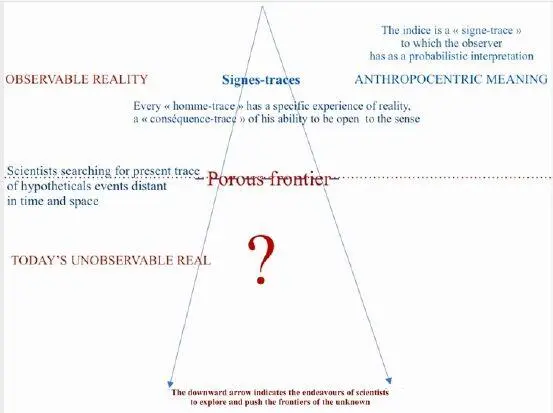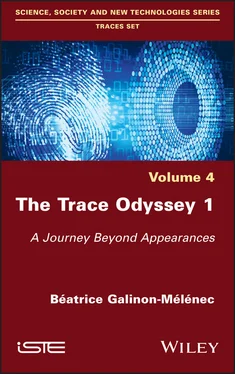As we shall see later on, a conséquence-trace can be posited as existing outside the perception that humans can have of it. For example: the whole universe that we currently know nothing of, but whose existence we axiomatically assume exists.
I.6. Distinguishing between “ trace anthropocentrée ” and “ trace ontologique ”
Figure I.1 seeks to remove the ambiguity surrounding the concept of trace and to distinguish the trace identified by human beings, which we call “ trace anthropocentrée ”, from the “ trace ontologique ”, which refers to the concept of what human beings do while they don’t have access to an assumed all-existing Real. Even if a person is not omniscient, the individual can nevertheless hypothesize that they result from a chain of conséquences-traces .
We return –in Chapter 4(Figure 4.4) and Chapter 5’s conclusion (Figure 5.5) –to what this distinction between “ trace anthropocentrée ” and “ trace ontologique ” imply; in particular, when (as we see in Figure I.1) it induces the position of the concept of the indice in the anthropocentric sense.
Obviously, this distinction is a debatable hypothesis, insofar as it is a human being who advances it; this hypothesis is thus necessarily anthropocentric. Nevertheless, we believe it is useful for considering the relationship between humans and the way in which they live.

Figure I.1. Distinguishing “trace anthropocentrée” from “trace ontologique”. For a color version of this figure, see www.iste.co.uk/galinonmelenec/traceodyssey.zip
In Figure I.1, the horizontal line separates today’s unobservable Real from an observable reality, which although unobservable is assumed to exist. For “today’s unobservable Real”, we posit the existence of an evolution that produces conséquences-traces that drive researchers to identify other, hypothetical existences. Then, using increasingly complex and efficient equipment, humans develop concepts that evolve in time and space to broaden a scientific understanding of the whole of known reality. In Figure I.1 the dotted line 18indicates that the frontier between a perceived reality and an assumed Real changes each day. In this sense, we see how the Real becomes reality (Galinon-Mélénec 2020).
The part above the horizontal line corresponds to the part observed by humans. As Paul Watzlawick states in How Real is Real 19(Watzlawick 1978), the belief that our perception of reality is the reality, is a dangerous illusion. In fact, each individual understands perceived reality differently. The different resulting representations cannot cover the totality of the Real whose existence is assumed, though not perceived in its entirety by humans.
The Trace Odyssey 1 illustrates this point by explaining that reality is perceived differently by each person according to a “ corps-trace ” that integrates –among other elements that we develop later –the conséquences-traces of their respective life history. The “ corps-trace ” induces representations in individuals about the perceived reality 20that do not perfectly overlap with other individuals’. This partial overlap can be explained by taking into account the conditioning openness to the reception of what surrounds individuals, the direction of attention to achieving objectives, and the reference points from the senses, emotions and affects. Given all these different factors, misunderstandings can occur in all communication between speakers, even those of the same language.
I.7. From “ trace anthropocentrée ” to the signe-trace
When we use the term signe-trace in Figure I.1, we place ourselves in an anthropocentric context.
DEFINITION.– In our paradigm, a sign is a part of a “réalité-trace” in the anthropocentric perception of an “homme-trace”. A sign is a “signe-trace” .
To designate a sign by the terminology “ signe-trace ” 21is to present the sign as a “ conséquence-trace ” of complex dynamic processes of “ conséquences-traces ” that we explain in the next part of the book.
Let us remember, for the moment, that:
– Placing the concept of trace in the context that we have just specified corresponds to our wish to offer the reader a critical approach to the “trivial” use of the term (Jeanneret 2014) and the taken-for-granted thoughtlessness that it implies. It is so “natural” to forget that the meaning of the term social is not necessarily shared (Hall 1984)22.
– Relationships between humans are no longer confined to a co-presence. They increasingly take place at a distance and are often established between people who are very far apart geographically, socially and culturally. It is therefore necessary to express oneself with words, whose nuances can be understood and interpreted correctly by different speakers. This is all the more important as the shift in usage between oral and written expression is spreading with the explosion of digital writing, which is now instantaneous23.
For this reason, if we place ourselves as a researcher in the information and communication sciences, addressing readers from other cultures or other sciences, we think it is appropriate to show the different levels of the use of the term “trace”. The different levels can be deconstructed to show their relativity and, finally, to reconstruct them on the basis of a linguistic consensus integrating definitions that allow us to distinguish the singularities of meaning between trace, sign, indice and imprint.
The relationship between these terms has already produced a significant number of publications, the most essential of which can be found in the References section. Controversies, sometimes very lively ones, among certain authors have provoked schools of thought.
For our part, guided by the idea of exploring the complexity of the concept of trace from an approach that we see as interdisciplinary, we propose to study the trace as a result of the influence of an event on its environment/milieu 24. This choice allows us to state that all the consequences of an event can be considered as a trace, hence the evocative term conséquences-traces . This enables us to situate the terms “imprint”, “mark” and indice in relation to the term conséquences-traces .
I.8. Need for agreement on terminology
In this book, we seek to test the acceptance of the terms “imprint”, “mark”, and “ indice ” as subsets of the “trace” class. This brings us closer to the statements of the Dictionnaire historique de la langue française (Rey and Hordé 2006) 25. The propositions, whose usefulness 26we examine with regard to the situations analyzed, are:
– the imprint27 is the conséquence-trace that we look at from the angle of a shape or material with a certain durability. The imprint is a category of traces (consequence of an event) whose form and/or material have a certain duration28;
– the mark29 is the conséquence-trace that we observe from the angle of the signifying differentiation. The mark is a category of conséquences-traces that constitutes a recognizable sign, distinctively and meaningfully30 identified;
– the indice31 is the conséquence-trace that we observe in order to identify what happened in the past. The indice is a trace category (consequence of an event)32 to which a cognitive interpreter associates an indexed causal inference with a scenario33.
Читать дальше













